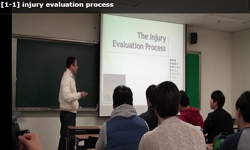The urban railway sleeper floating track(STEDEF) is a structure that structurally separates the sleepers and the concrete bed using sleeper boots and resilience pads to reduce vibration transmitted to the concrete bed. Recently, the resilience pads of...
http://chineseinput.net/에서 pinyin(병음)방식으로 중국어를 변환할 수 있습니다.
변환된 중국어를 복사하여 사용하시면 됩니다.
- 中文 을 입력하시려면 zhongwen을 입력하시고 space를누르시면됩니다.
- 北京 을 입력하시려면 beijing을 입력하시고 space를 누르시면 됩니다.

모달시험기법을 이용한 침목플로팅궤도의 고유진동수 분석 = Natural Frequency Analysis of Sleeper Floating Track System using Modal Test Technique
한글로보기https://www.riss.kr/link?id=A109080880
-
저자
최정열 (동양대학교)
- 발행기관
- 학술지명
- 권호사항
-
발행연도
2024
-
작성언어
Korean
-
주제어
침목플로팅궤도 ; 모달시험 ; 동특성 ; 열화 ; 손상 ; Sleeper floating track ; Modal test ; Dynamic characteristic ; Deterioration ; Damage
-
등재정보
KCI등재
-
자료형태
학술저널
-
수록면
833-838(6쪽)
- DOI식별코드
- 제공처
-
0
상세조회 -
0
다운로드
부가정보
다국어 초록 (Multilingual Abstract)
The urban railway sleeper floating track(STEDEF) is a structure that structurally separates the sleepers and the concrete bed using sleeper boots and resilience pads to reduce vibration transmitted to the concrete bed. Recently, the resilience pads of sleeper floating tracks that have been in use for more than 20 years are deteriorating. Accordingly, in order to evaluate the performance of the resilience pad, a static spring stiffness test is being performed after extracting the resilience pad. This evaluation technique is performed after replacing the resilience pad in use. However, the track natural frequency can change depending on the resilience pad spring stiffness and the uplift and subsidence of the concrete bed. In this study, modal testing technique was used to evaluate the track natural frequency. For this purpose, the sleeper boots material, resilience pad spring stiffness, and track natural frequency according to concrete bed uplift and subsidence were measured using modal tests at a laboratory scale. It was analyzed that the natural frequency of the sleeper floating track was directly affected by changes in the spring stiffness of the resilience pad. In addition, the change in natural frequency due to the uplift and subsidence of the concrete bed was also found to be large. Therefore, it is believed that the modal test technique presented in this study can be used to evaluate the resilience pad deterioration and voided sleepers.
동일학술지(권/호) 다른 논문
-
스트레처블 디스플레이가 적용된 모바일 기기의 보안 키패드 연구
- 국제문화기술진흥원
- 최동민
- 2024
- KCI등재
-
통합예술을 토대로 조형원리를 적용한 아트메이크업 디자인 분석
- 국제문화기술진흥원
- 안나현
- 2024
- KCI등재
-
로페로마이드로 유도한 변비랫드 모델에서 프락토올리고당 및 과채복합 추출물의 변비개선 효과
- 국제문화기술진흥원
- 김현경
- 2024
- KCI등재
-
미디어 산업 AI 활용성에 관한 고찰: 저널리즘 분야 적용의 주요 쟁점을 중심으로
- 국제문화기술진흥원
- 한정현
- 2024
- KCI등재




 ScienceON
ScienceON eArticle
eArticle






